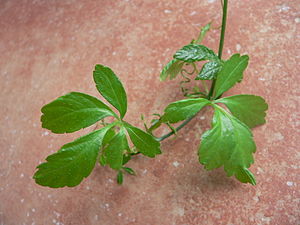Note: This is a project under development. The articles on this wiki are just being initiated and broadly incomplete. You can Help creating new pages.
Difference between revisions of "Gynostemma pentaphyllum - Jiaogulan"
(→External Links) |
(→References) |
||
| (3 intermediate revisions by the same user not shown) | |||
| Line 1: | Line 1: | ||
[[File:Jiaogulan.JPG|thumb|right|''Jiaogulan'', ''Gynostemma pentaphyllum'']] | [[File:Jiaogulan.JPG|thumb|right|''Jiaogulan'', ''Gynostemma pentaphyllum'']] | ||
| − | + | '''Gynostemma pentaphyllum''' is a dioecious, herbaceous climbing vine of the family Cucurbitaceae indigenous. it normally grows in China, northern Vietnam, southern Korea, and Japan. | |
| − | |||
| − | |||
==Uses== | ==Uses== | ||
{{Uses|Blood sugar}}, {{Uses|Cholesterol}}, {{Uses|Blood pressure}}, {{Uses|Nervous tension}}, {{Uses|Peptic ulcer}}, {{Uses|Asthma}}, {{Uses|Bronchitis}}, {{Uses|Diabetes}}, {{Uses|Cardiovascular}}, {{Uses|Cancer}} | {{Uses|Blood sugar}}, {{Uses|Cholesterol}}, {{Uses|Blood pressure}}, {{Uses|Nervous tension}}, {{Uses|Peptic ulcer}}, {{Uses|Asthma}}, {{Uses|Bronchitis}}, {{Uses|Diabetes}}, {{Uses|Cardiovascular}}, {{Uses|Cancer}} | ||
| Line 42: | Line 40: | ||
===Fruit=== | ===Fruit=== | ||
| − | {{Fruit||7–10 mm (0.28–0.4 in.) long pome| | + | {{Fruit||7–10 mm (0.28–0.4 in.) long pome|Clearly grooved lengthwise, Lowest hooked hairs aligned towards crown|With hooked hairs|}} |
===Other features=== | ===Other features=== | ||
| Line 67: | Line 65: | ||
<references> | <references> | ||
| − | <ref name="chemical composition">[https://www.sciencedirect.com/science/article/pii/S0378874112006393?via%3Dihub | + | <ref name="chemical composition">[https://www.sciencedirect.com/science/article/pii/S0378874112006393?via%3Dihub Chemical constituents]</ref> |
| − | <ref name="Leaf">[https://web.archive.org/web/20131226161459/http://www.wildflowers-guide.com/39-agrimony.html | + | <ref name="Leaf">[https://web.archive.org/web/20131226161459/http://www.wildflowers-guide.com/39-agrimony.html Wayback machine]</ref> |
| − | <ref name="How to plant/cultivate">[https://www.pfaf.org/User/Plant.aspx?LatinName=Gynostemma+pentaphyllum | + | <ref name="How to plant/cultivate">[https://www.pfaf.org/User/Plant.aspx?LatinName=Gynostemma+pentaphyllum Cultivation details]</ref> |
</references> | </references> | ||
Latest revision as of 16:14, 14 May 2020
Gynostemma pentaphyllum is a dioecious, herbaceous climbing vine of the family Cucurbitaceae indigenous. it normally grows in China, northern Vietnam, southern Korea, and Japan.
Contents
- 1 Uses
- 2 Parts Used
- 3 Chemical Composition
- 4 Common names
- 5 Properties
- 6 Habit
- 7 Identification
- 8 List of Ayurvedic medicine in which the herb is used
- 9 Where to get the saplings
- 10 Mode of Propagation
- 11 How to plant/cultivate
- 12 Commonly seen growing in areas
- 13 Photo Gallery
- 14 References
- 15 External Links
Uses
Blood sugar, Cholesterol, Blood pressure, Nervous tension, Peptic ulcer, Asthma, Bronchitis, Diabetes, Cardiovascular, Cancer
Parts Used
Chemical Composition
Phenolic, saponin, and flavonoid[1]
Common names
| Language | Common name |
|---|---|
| Kannada | |
| Hindi | |
| Malayalam | |
| Tamil | |
| Telugu | |
| Marathi | NA |
| Gujarathi | NA |
| Punjabi | NA |
| Kashmiri | NA |
| Sanskrit | |
| English | Jiaogulan |
Properties
Reference: Dravya - Substance, Rasa - Taste, Guna - Qualities, Veerya - Potency, Vipaka - Post-digesion effect, Karma - Pharmacological activity, Prabhava - Therepeutics.
Dravya
Rasa
Guna
Veerya
Vipaka
Karma
Prabhava
Habit
Identification
Leaf
| Kind | Shape | Feature |
|---|---|---|
| Simple | The leaves are divided into 3-6 toothed leaflets, with smaller leaflets in between |
Flower
| Type | Size | Color and composition | Stamen | More information |
|---|---|---|---|---|
| Unisexual | 2-4cm long | Yellow | 5-20 | Flowers Season is June - August |
Fruit
| Type | Size | Mass | Appearance | Seeds | More information |
|---|---|---|---|---|---|
| 7–10 mm (0.28–0.4 in.) long pome | Clearly grooved lengthwise, Lowest hooked hairs aligned towards crown | With hooked hairs | {{{6}}} |
Other features
List of Ayurvedic medicine in which the herb is used
- Vishatinduka Taila as root juice extract
Where to get the saplings
Mode of Propagation
How to plant/cultivate
Requires a rich well-drained but moisture-retentive soil in a warm sheltered position in partial shade[3]
Commonly seen growing in areas
Tall grasslands, Meadows, Borders of forests and fields.
Photo Gallery
References
External Links
- Ayurvedic Herbs known to be helpful to treat Blood sugar
- Ayurvedic Herbs known to be helpful to treat Cholesterol
- Ayurvedic Herbs known to be helpful to treat Blood pressure
- Ayurvedic Herbs known to be helpful to treat Nervous tension
- Ayurvedic Herbs known to be helpful to treat Peptic ulcer
- Ayurvedic Herbs known to be helpful to treat Asthma
- Ayurvedic Herbs known to be helpful to treat Bronchitis
- Ayurvedic Herbs known to be helpful to treat Diabetes
- Ayurvedic Herbs known to be helpful to treat Cardiovascular
- Ayurvedic Herbs known to be helpful to treat Cancer
- Herbs with Leaves used in medicine
- Herbs with Aerial parts used in medicine
- Herbs with common name in English
- Habit - Herb
- Index of Plants which can be propagated by Seeds
- Herbs that are commonly seen in the region of Tall grasslands
- Herbs that are commonly seen in the region of Meadows
- Herbs that are commonly seen in the region of Borders of forests and fields
- Herbs
- Ayurvedic herbs that don't have flower, fruit and leaf photos
- Ayurvedic herbs that don't have seed photos
- Cucurbitaceae
